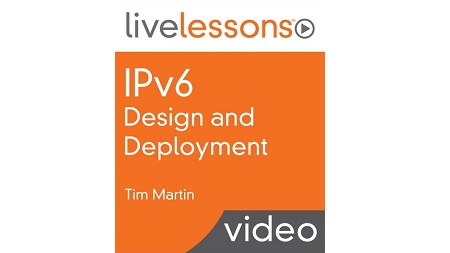
English | MP4 | AVC 1280×720 | AAC 44KHz 2ch | 6h 16m | 1.87 GB
More than 6 hours of video training covering all aspects of deploying and designing IPv6 in Cisco networks.
IPv6 Design and Deployment LiveLessons is a comprehensive video training course that explains everything you need to know about deploying IPv6 in your enterprise environment. The information compiled here will aid you in leading your organization to a rich and full deployment of IPv6. You will find a balance between what you need to know to design IPv6 in the enterprise and what you need to know to deploy IPv6.
There are 10 lessons with more than 6 hours of video training in IPv6 Design and Deployment LiveLessons. Coverage includes
- Design Considerations
- IPv6 Protocol
- General Design Principles
- Host Role in IPv6
- IPv6 Network Services
- Campus Design Considerations
- Data Center
- Wide Area Networking
- Translation Techniques
- The Internet Edge
What You Will Learn
- Topical, up-to-date information for IPv6 deployments
- The ins and outs of designing and deployment IPv6
Who Should Take This Course
- Enterprise network architects
- Network engineers
- Network technicians
- Operations technicians with a networking background
- Former or current CCNAs, CCNPs, CCIEs, and CCDEs
Table of Contents
01 IPv6 Design and Deployment LiveLessons – Introduction
02 Module Intro
03 1.0 Learning objectives
04 1.1 Examining Address Depletion
05 1.2 How the Infrastructure Providers Are Implementing IPv6
06 1.3 National Strategies for IPv6 Deployment
07 1.4 Your Operating Systems Are Already IPv6 Enabled
08 1.5 Understanding the Impact of the “Bring Your Own Device” Era
09 1.6 Understanding the Impact of “The Internet of Things”
10 2.0 Learning objectives
11 2.1 IPv6 Is Big and Size Matters
12 2.2 Introducing the IPv6 Address Family
13 2.3 Making Hex Easy
14 2.4 Differentiating Prefix from Subnet
15 2.5 Understanding Why Link Local Is Required
16 2.6 Visiting Headers and Friends
17 3.0 Learning objectives
18 3.1 Preparing the Project Plan
19 3.2 Obtaining IPv6 Addresses
20 3.3 Determining Where to Start
21 3.4 Building the Address Plan
22 3.5 When to Use Tunneling
23 3.6 Examining Dual Stack
24 3.7 Dealing with Combined IPv4 and IPv6
25 3.8 Examining Link Local Only Infrastructure
26 3.9 Understanding Unique Local Addressing
27 4.0 Learning objectives
28 4.1 Understanding Host Provisioning Mechanisms
29 4.2 Decrypting the Flags, Bits and Timers
30 4.3 Surveying Relevant RFCs
31 4.4 Examining Windows in an IPv6 Environment
32 4.5 Examining Mac OSX in an IPv6 Environment
33 4.6 Examining Linux in an IPv6 Environment
34 4.7 Examining Chromebook in an IPv6 Environment
35 4.8 Examining Mobile OS’s in an IPv6 Environment
36 4.9 Examining Consumer Devices in an IPv6 Environment
37 5.0 Learning objectives
38 5.1 Deploying DHCPv6
39 5.2 Deploying IPv6 DNS
40 5.3 Managing IPv6 Addresses
41 5.4 Implementing IPv6 Multicast
42 5.5 Multicast Listener Discovery (MLD)
43 5.6 Understanding IPv6 Zero Configuration
44 5.7 Surveying IPv6 Management Tools
45 Module Intro
46 6.0 Learning objectives
47 6.1 Applied Concepts for Campus and Core
48 6.2 Comparing Layer 2 and Layer 3 Access
49 6.3 Examining First Hop Redundancy
50 6.4 Examining First Hop Security – Thread Identification
51 6.5 Examining First Hop Security – Attacks and Mitigation Techniques
52 6.6 Implementing Wireless Access Layer
53 6.7 Scaling the Distribution Layer
54 6.8 Securing the RP-OSPFv3, EIGRP
55 6.9 Implementing Unified Communications
56 7.0 Learning objectives
57 7.1 Grasping Transition Stages
58 7.2 Considerations for Storage Area Networks
59 7.3 Examining Data Center Interconnect
60 7.4 Scaling the Neighbor Cache
61 7.5 Verifying Server Readiness
62 7.6 Planning for Application Migration
63 7.7 Considering Cloud Services
64 8.0 Learning objectives
65 8.1 Understanding Remote Branch Design
66 8.2 Considering Dynamic Multipoint VPN
67 8.3 Exploring MACsec
68 8.4 Examining Multiprotocol Label Switching
69 8.5 Exploring Segment Routing
70 8.6 Deploying Remote Access VPN
71 9.0 Learning objectives
72 9.1 Understanding Network Address Translation
73 9.2 Considering NAT64
74 9.3 Implementing Server Load Balancing
75 9.4 Understanding Proxy Services
76 9.5 Examining Web Cache Control Protocol
77 9.6 Understanding Network Prefix Translation
78 10.0 Learning objectives
79 10.1 Surveying Design Scenarios
80 10.2 Implementing BGP Multihoming
81 10.3 Examining Multihome, Multisite
82 10.4 Considering Location Identification Separation Protocol
83 10.5 Mitigating Risk with Security
84 IPv6 Design and Deployment LiveLessons – Summary
Resolve the captcha to access the links!